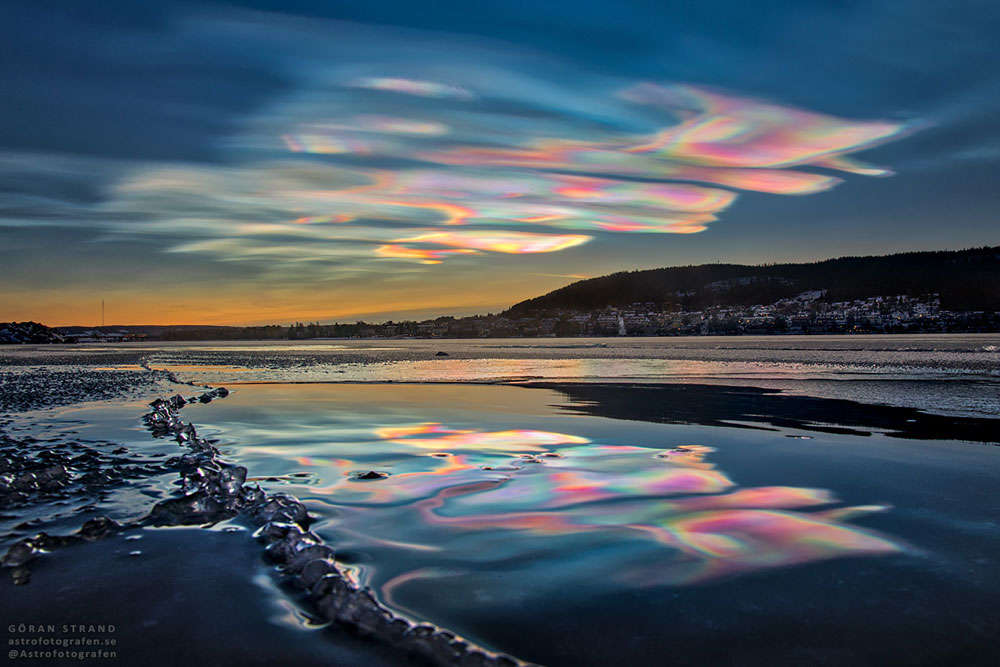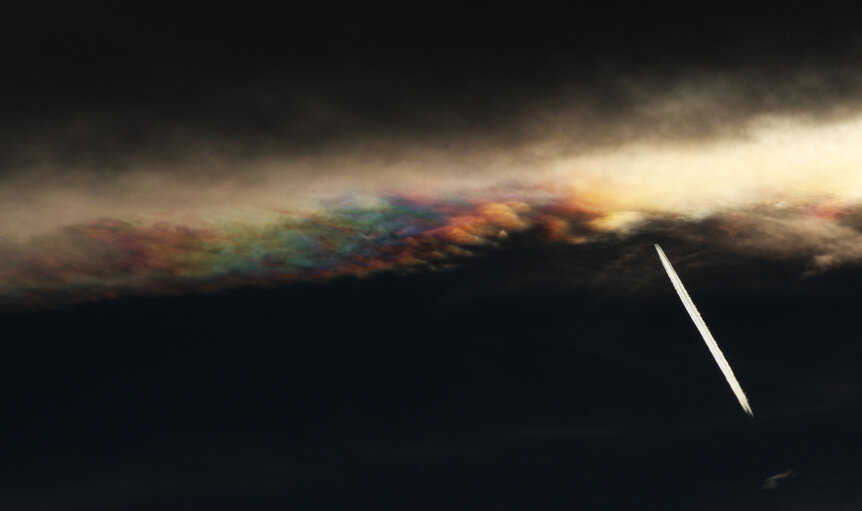Create a free profile to get unlimited access to exclusive videos, sweepstakes, and more!
The eerie, unearthly sight of polar stratospheric clouds

I am something of a nephophile — and before you get all snickery and snarky, it comes from the Greek nephos, for "cloud"* — and I truly enjoy seeing images and videos of interesting and unusual clouds.
I live east of the Rocky Mountain foothills, and the wind patterns here generate a lot of unusual-looking clouds. I've seen all manners of them, including fluctus (another snicker-inducing name), mammatus (a snicker-inducing formation), lenticulars, and more.
I've also seen my share of iridescent clouds, but I have never, ever, seen them like this:
Holy constructive interference! Those are incredible!
That video was taken by astrophotographer Göran Strand, who shot it in Sweden on New Year's Eve 2019. The clouds are called polar stratospheric clouds, and they're very, very strange.
They only form at high latitudes, in the Arctic or Antarctic (hence the first adjective in their name), and occur very high up in the atmosphere, around 15,000 meters or higher, in the stratosphere (hence the second adjective). They're difficult to see at night or during the day, but they're so high up that at twilight they're still lit by the Sun long after it sets for someone on the ground, making them more easily visible.
There are different kinds, though they all consist of tiny water ice particles; some have small amounts of chemicals in them like nitric acid. Because some can shine with a silvery, mother-of-pearl glow to them they're also called nacreous clouds.
They commonly take on a thin, wavy appearance (like cirrus clouds) but other times can be thicker and puffier, like the ones Strand saw. These can become lens-shaped if sculpted by wind, so they are technically lenticular clouds, too (which means "lens-shaped"). They appear to hover there, but that's an illusion...
Regular lenticular clouds form in the troposphere (the lower atmosphere layer) when moving air is pushed upwards by a mountain range or other obstruction. As the air flows past it moves upward and cools, becomes denser so it falls, warms up as it does so and then rises again, on and on. The driving force of this buoyancy is gravity, so we call these gravity waves.
The biggest wave occurs just downwind of the obstruction, and as air moves upward the water vapor in it can condense to form clouds. They appear to hover in that spot, but that's the illusion; the air is still flowing past them. It just that the water vapor condenses to form clouds in that spot, so the cloud becomes visible there. Clouds can form at the crests of the wave downwind, too, creating striped clouds across the sky.
The stratosphere is the layer above the troposphere, and if the lower layer rises up it can push on the stratrospheric layer above it and it will rise as well. So the waves in the troposphere can create waves in the stratosphere above them, so polar stratospheric clouds can also appear to hover in one spot.
But the color! That's due to iridescence. Light is a wave (though one that's based on electromagnetic energy, not air flow), and as it bounces around inside the ice-particle cloud the waves interfere with each other, changing the shape of the wave — this is just like when you sit in a bathtub and move around; time it right and the waves you create can add together, creating a big slosh of water (similar to a seiche). We perceive the shapes of these electromagnetic waves as colors, so this process produces amazing and weird colors as the light waves self-interfere.
This is relatively common in everyday clouds if the water particles are tiny enough, especially near their edges where the density of them is lower, allowing light to pass through them more easily. I see this all the time, in fact, though usually it helps a lot to use a polarizing filter (like in sunglasses) to see the colors more easily. But the polar stratospheric clouds Strand saw were spectacularly vivid, and he didn't even use a filter to record them! The striking colors are more common in these high-altitude clouds.
So, apparently, I need to add yet another amazingly jaw-dropping thing to my list of stuff I want to see in this lifetime. Imagine standing there in northern Sweden, the sky a deep purple edging into black, and the clouds to the west brilliantly aglow with colors that looked like they spilled out of Willy Wonka's factory. It would be worth freezing my butt off to see that, just once.
You can follow Strand on Twitter and Instagram to keep up with his brilliant photography.
*For all my life I've been saying that the word nebula, which in astronomy is what we call a cloud of gas and/or dust, comes from the Greek word for cloud, but in fact it comes from the Latin word for fog. That makes sense, but I was surprised to learn this, especially literally now as I looked up what the word for cloud lover was for this very article. My nebulaphilic life has been a lie.
















